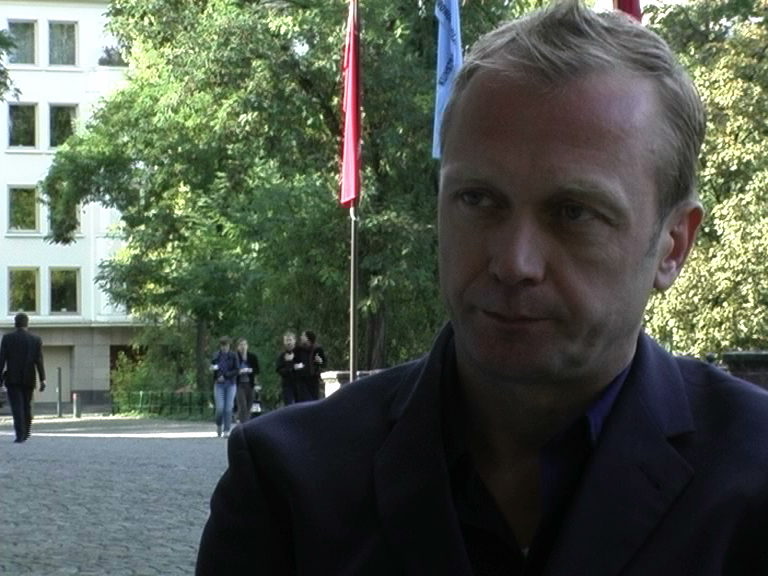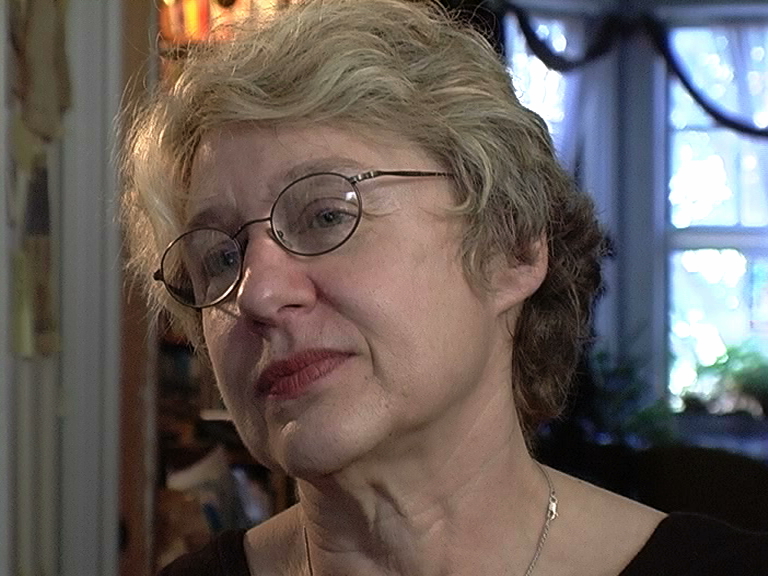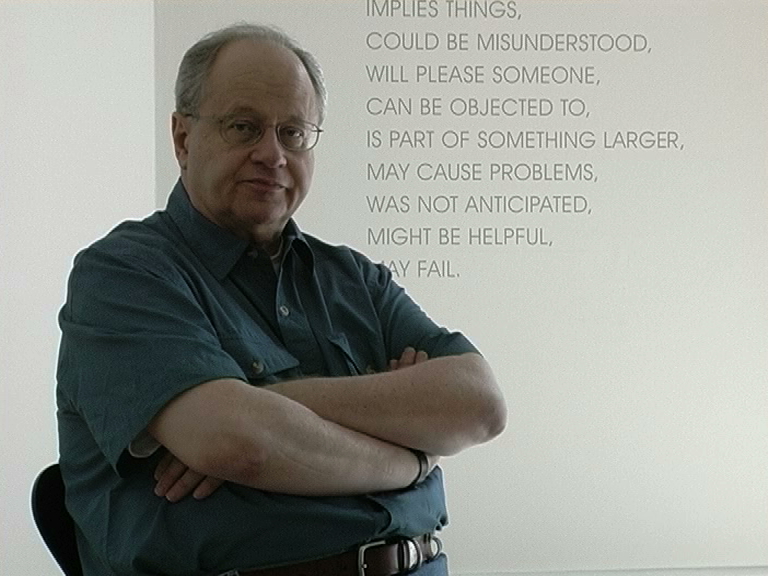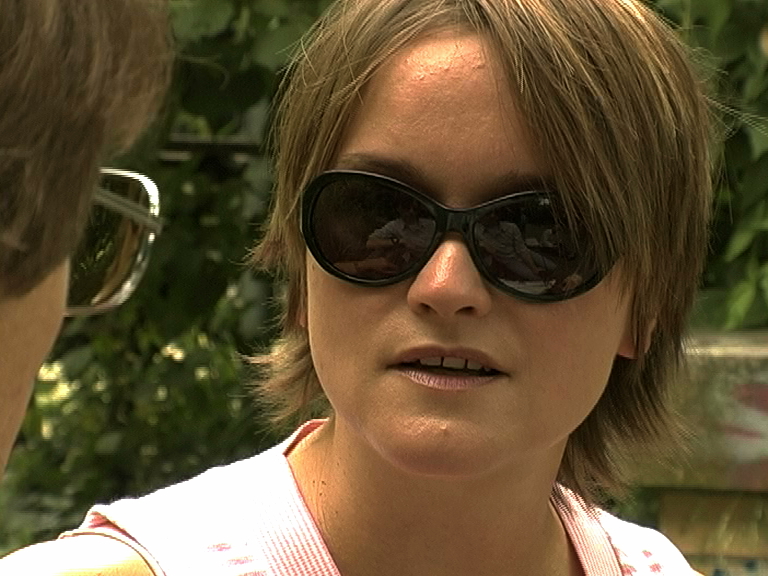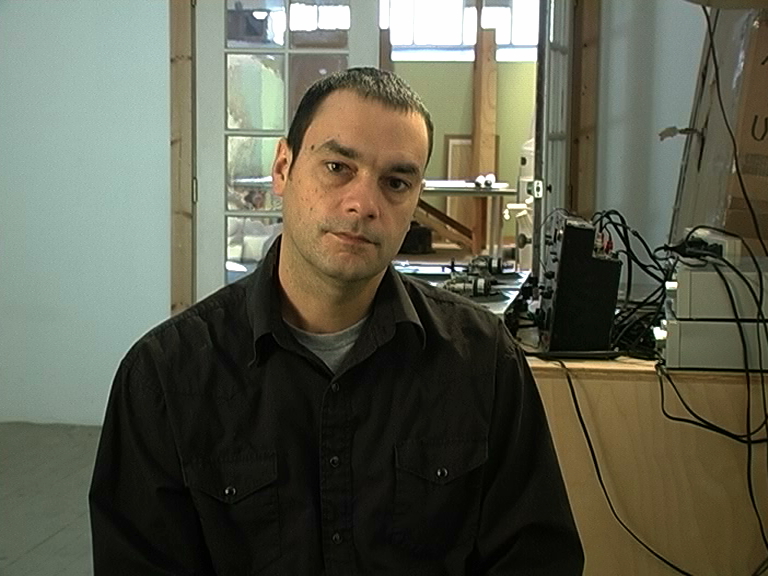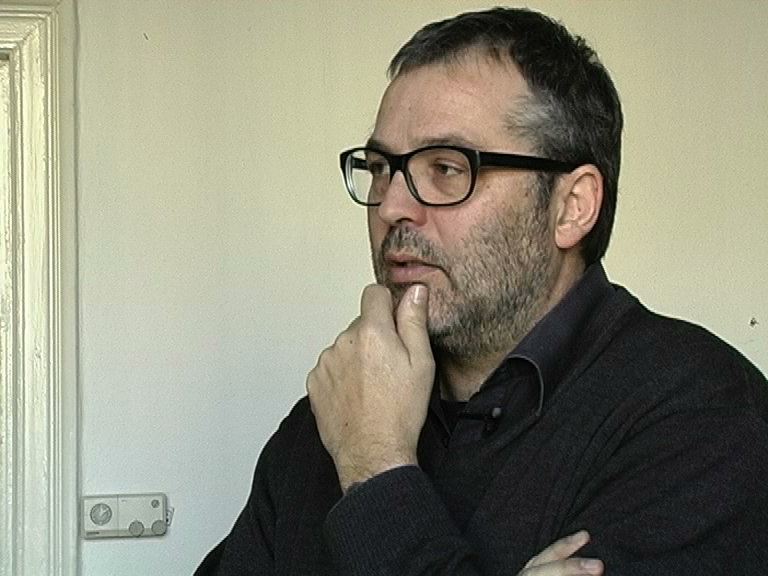S.R.: Would you like to say something about your intellectual relation to Conceptualism?
V.S.: Well, I think that in the last 10 years or so my work – as it moved away from painting into the area of kind of new sculpture, installation, video, the uses of photography in particular – I found myself thinking very much in terms of both an image – as a painter I was engaged with making images as well as narratives – to framing devices and structures which certainly demand a certain kind of reflective intellectual approach where the aspect of structure, of the space – which is public space, in a sense as site-specific installation would be –, of strategies of a critique of the artist as author, author with a signature; many of these have… (Schnitt) Well, the aspect of the notion of the author as the artist, the artist as the author of the painting which primarily you are, but the minute you move to another kind of art-making-practice which I’ve been engaged with. Then there is a sort of process of self-criticism which has been going on gradually about in fact widening the frame – once you get out of the format of the easel-painting frame – to allow other voices, to allow in fact the singular artist-signature voice to be always present. And this work in particular reaches another point which I can speak later on about.
S.R.: In relation to that: What was the strongest influence on your work?
V.S.: It’s very difficult to say one strong influence but I think that taking at one level the tradition coming down from Duchamp, and, second, into the 80s as installation art became more and more a form that allowed these multiple strategies in a sense to be in the work, to be inclusive rather than to be exclusive. So I think that – without naming any particular artist – but if an interest in space in relationship to architecture, then the work of Kabakov comes to mind, where you, in a sense, enter the sculptural object which is quasi architectural. The idea of sculpture as shelter or sculpture as rooms, as I have done here. So I think that in this broad sense this desire to link to very many disciplines within one work is one of my desires to kind of explore different aspects of what would be a form of engagement. And then in fact my relationship to many other practitioners, to in some way re-present them or engage with their practice is now at the moment a very important concern.
S.R.: Can you figure out one specific aim of your practice?
V.S.: You know this word, “one“ I’m basically opposed to because I find that on one hand one is made up of series of fragments, their contradictory aspect. But I’m also interested in a desire to make an attempt to relate the various parts of oneself to a kind of whole. But the wish to be an artist which can engage with a wide spectrum of issues, not to be named as a person who just deals with the personal or with the political whose medium is X, Y or Z. In a way the kind of relay of – both thematically as well as the mediums as a kind of relay – a kind of interconnectivity starts taking place. And here then also the viewer in a sense starts putting the various parts together. My work in terms of certain aesthetics is often very formal, and so I hope that some of these formal structures allow one, that they contain a large diversity of subject matter and references.
S.R.: Do you think that the conceptual paradigms are still in function?
V.S.: Well, as I said, the beginnings of my work have not come from any conceptual source in the sense were were just talking about, conceptual as of some kind of philosophic position. For me politics is in fact the kind of core of the reason of making work, and politics is also very inclusive in its referentiality. But it’s the politics of relationships, it’s the politics of collective, it’s the politics of community, it could be the politics of place or city, it could be a very straight relationship to Marxist politics. So I think that becomes much more my central basis rather than purely something that would be what you are calling conceptual.
S.R.: How do you describe your ideal typical daily work as an artist?
V.S.: No, there again, I have on one hand, very undisciplined. I do not have any regular routine, and in fact in the last 12 or 13 years ever since I stopped making art as a painter going to the studio and painting, one of the great satisfactions has been – as I have moved into making objects and sculpture and installation, and not being trained as a sculptor – that in fact the city and various parts of Delhi become in fact my work places. I often, as I move about I’m looking for the material, I want a certain thing to be crafted. It’s with great pleasure that I have actually discovered parts of Delhi and sometimes they could be 20 kilometers away, and this recent work which is here now in the House of World Culture. In the middle of summer I was in fact travelling 25 km from one part of Delhi to the other because something was being made in one place and I had to go to another place to pick that up. And I think that this journeying across the city and making art is something which to me – the whole notion of the privacy of the artist studio, this completely opens out, and that’s been very gratifying. Not that I do not love to go and be in the studio and make things, or I’m making now works from the computer, digital images or doing video – so that of course then you are working very much with technology.
S.R.: If I understand right, you bring together medial and handicrafted production processes. May be there is still a kind of conceptual process?
V.S.: Well, in that sense, very much so. It’s an interest to link what one would call pre-industrial craft to post-industrial, new technologies. The fact that India is still vibrantly living with this spectrum, it’s so often stated. But in a way it also has to be meaningful in terms of a theme or a narrative that I’m engaged with and I would then in fact pick up sometimes a theme that could bring this spectrum. It’s not necessarily programmed in that way. But, as I said, it’s conceptual in the sense of a notion where craft and skill are present in the work but to the extent that it is entirely made by a person, that does not exist, that becomes apparent in the work. Then it then becomes in a sense socialized art production, after all even when a film maker is producing a film with the collective expertise of such a wide spectrum of people. My best friend is a great film maker. And I’ve often thought that installation art also has those sorts of possibilities. At one moment I’m doing a bit high-tech editing for the video, then I go to get some cast iron pipe to be cut which is not easy to do. That’s like so 19th century industrial product, a cast iron pipe. So a simple thing like that, to get it just cut, it took me days to find a person with a lathe who would cut that. I think that it’s this experience of the socialized space in it’s production then kind of informs finally the work itself.
S.R.: If you want to say anything, now its the right time to ad. For example you spoke about originality in relation to the conceptualism.
V.S.: Well, just this aspect of the artist being able to be, just many things at once – of course there is a risk – but on one hand to be very personal and autobiographical on one hand, and on the other the artist as a curator, the artist as an archivist, the artist as somebody who represents other people’s creativitiy. But finally it’s sort of something that says something about my self or some things that you wanted to do, one wants to do so many things and one can’t do, and one wants to be many things, or if you meet a young artist and they have done something. And then you think, you missed doing that in your own youth for whatever reasons. And so you kind of connect to youth in one way. There is some shocking element, you couldn’t do it but you are representing them. It’s like a kind of foil or a play on your own past which you missed out on. And on the other hand there could be aspects of say, in my kind of political frame, which they do not include certain metaphysical or spiritual ideas. One of my closest friends is an architect. He is engaged with Buddhist thought and philosophy but he is a completely modern avant-garde architect. It would not be possible for me to think of including images of the Buddha in my work. But somewhere, where in today’s Indian politics, in the way that the need for having certain kinds of transcending forces that give a sense of being able to come back together, all the fragments that exist. Then a voice like that that can be part of your work through somebod else’s in a long experience. I get great pleasure in that. Of course people say, but where are you in this work. I think that’s the work the viewer has to do, it’s a risk one takes. But I think that everybody is very deeply attached to the singular image, the singular voice. Joseph Beuys always has one basic core which everybody is in search of. That’s not my ideal of the socialized. You know he talked about social sculpture. But I think it has to be placed with a different sort of paradigms. In a sense a post-bourgeois artist but not necessarily socialist.
S.R. Thank you.


























